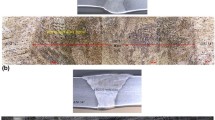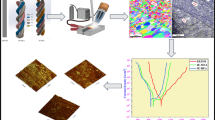Abstract
The corrosion behavior of fusion zones (FZ-1: 5.39 Mg–0.66Mn, FZ-2: 5.49 Mg–0.35Mn, and FZ-3: 5.72 Mg–0.32Mn) of AA5083 alloy welded with high Mg-containing Al–Mg filler wires has been systematically investigated. An extensive microstructural characterization was performed to evaluate the localized corrosion properties of the fusion zones. The potentiodynamic polarization test and salt spray test showed that the corrosion resistance decreases with increasing Mg content, therefore, the corrosion resistance of FZ-3 is lower than that of the FZ-1 and FZ-2. The electron microscopic analysis after intermittent corrosion test revealed that the eutectic β-phase (Al3Mg2) was responsible for the initiation of corrosion. The corrosion behavior of each microstructural constituents was related to the dissolution potentials of the corresponding microstructures; hence, it forms galvanic couple with the Al matrix. Moreover, high Mg content in the filler wire lead to the formation of additional β-phase in the fusion zone. However, intermetallics such as Al6(Fe,Mn) and Mg2Si were significant only during the later stages of corrosion.
Graphical abstract













Similar content being viewed by others
Data availability
The raw/processed data required to reproduce these findings cannot be shared at this time due to technical or time limitations.
References
M. Liu, P. Schmutz, S. Zanna, A. Seyeux, H. Ardelean, G. Song, A. Atrens, P. Marcus, Corros. Sci. 52, 562 (2010). https://doi.org/10.1016/j.corsci.2009.10.015
D.S. D'Antuono, β Phase Growth and Precipitation in the 5xxx Series Aluminum Alloy System (2017)
Y. Zhu, D.A. Cullen, S. Kar, M.L. Free, L.F. Allard, Metall. Mater. Trans. A. 43, 4933 (2012). https://doi.org/10.1007/s11661-012-1354-7
R. Goswami, G. Spanos, P.S. Pao, R.L. Holtz, Sci. Eng. A. 527, 1089 (2010). https://doi.org/10.1016/j.msea.2009.10.007
J.L. Searles, P.I. Gouma, R.G. Buchheit, Metall. Mater. Trans. A Phys. Metall. Mater. Sci. 32, 2859 (2001). https://doi.org/10.1007/s11661-001-1036-3
D. Mizuno, R.G. Kelly, Corrosion 69, 681 (2013). https://doi.org/10.5006/0813
S. Jain, J.L. Hudson, J.R. Scully, Electrochim. Acta 108, 253 (2013). https://doi.org/10.1016/j.electacta.2013.06.036
R. Zhang, S.P. Knight, R.L. Holtz, R. Goswami, C.H.J. Davies, N. Birbilis, Corrosion 72, 144 (2016). https://doi.org/10.5006/1787
R.K. Gupta, R. Zhang, C.H.J. Davies, N. Birbilis, Corrosion 69, 1081 (2013). https://doi.org/10.5006/0948
Y.K. Yang, T.R. Allen, Metall. Mater. Trans. A Phys. Metall. Mater. Sci. 44, 5226 (2013). https://doi.org/10.1007/s11661-013-1837-1
K.A. Yasakau, M.L. Zheludkevich, S.V. Lamaka, M.G.S. Ferreira, Electrochim. Acta 52, 7651 (2007). https://doi.org/10.1016/j.electacta.2006.12.072
F.L. Zeng, Z.L. Wei, J.F. Li, C.X. Li, X. Tan, Z. Zhang, Z.Q. Zheng, Trans. Nonferrous Met. Soc. China 21, 2559 (2011). https://doi.org/10.1016/S1003-6326(11)61092-3
A. Block-Bolten, T.W. Eagar, Metall. Trans. B. 15, 461 (1984). https://doi.org/10.1007/BF02657376
J.-B. Wang, H. Nishimura, S. Katayma, M. Mizutani, Sci. Technol. Weld. Joi. 16, 418 (2011). https://doi.org/10.1179/1362171810Y.0000000030
ASM Handbook, Volume 2: Properties and Selection: Nonferrous Alloys and Special Purpose Materials (1987)
Occupational Safety and Health Administration (OSHA), Proposed rule occupational exposure to beryllium and beryllium compounds in construction and shipyard sectors, n.d. https://www.osha.gov/beryllium/nprm_sectors/index.html. Accessed 12 Sept 2018
E.L. Huskins, B. Cao, K.T. Ramesh, Mater. Sci. Eng. A 527, 1292 (2010). https://doi.org/10.1016/j.msea.2009.11.056
S.G. Kim, Y.Y. Ok, S.J. Ho (2011), Oxidation-resistant aluminum alloy and manufacturing method thereof. https://patents.google.com/patent/KR101273582B1/en. Accessed 16 Feb 2019
Ø. Ryen, O. Nijs, E. Sjölander, B. Holmedal, H.E. Ekström, E. Nes, Metall. Mater. Trans. A Phys. Metall. Mater. Sci. 37, 1999 (2006). https://doi.org/10.1007/s11661-006-0142-7
ASTM International, ASTM B117-standard practice for operating salt spray test fog apparatus, 2011. https://doi.org/10.1520/B0117-11.2
International Organization for Standardization (ISO), ISO 9227:2012-corrosion tests in artificial atmospheres (Salt spray tests), 2012. https://doi.org/10.1007/s11367-011-0297-3
ASTM International, Standard practice for preparing, cleaning and evaluating corrosion test, 1999. https://doi.org/10.1520/G0001-03R11.2
ASTM International, Standard reference test method for making potentiodynamic anodic polarization measurements, 2015. https://doi.org/10.1520/G0005-14.2
O. Engler, K. Kuhnke, J. Hasenclever, J. Alloys Compd. 728, 669 (2017). https://doi.org/10.1016/j.jallcom.2017.09.060
Y. Liu, G. Huang, Y. Sun, L. Zhang, Z. Huang, J. Wang, C. Liu, Materials 9, 88 (2016). https://doi.org/10.3390/ma9020088
ASTM International, G102-Standard practice for calculation of corrosion rates and related information from electrochemical measurements 1 rosion test specimens ASTM International. G102–89 (2008) 1–7. https://doi.org/10.1520/G0102-89R10.2
H.M. Ezuber, Mater. Corros. 63, 111 (2012). https://doi.org/10.1002/maco.201005667
H. Ezuber, A. El-Houd, F. El-Shawesh, Mater. Des. 29, 801 (2008). https://doi.org/10.1016/j.matdes.2007.01.021
R. Goswami, R.L. Holtz, Metall. Mater. Trans. A Phys. Metall. Mater. Sci. 44, 1279 (2013). https://doi.org/10.1007/s11661-012-1166-9
S.W. Nam, D.H. Lee, Met. Mater. 6, 13 (2000). https://doi.org/10.1007/BF03026339
M.S. Remoe, K. Marthinsen, I. Westermann, K. Pedersen, J. Royset Mater. Sci. Eng. A 693, 60 (2017). https://doi.org/10.1016/j.msea.2017.03.078
N. Birbilis, R.G. Buchheit, J. Electrochem. Soc. 152, B140 (2005). https://doi.org/10.1149/1.1869984
L. Tan, T.R. Allen, Corros. Sci. 52, 548 (2010). https://doi.org/10.1016/j.corsci.2009.10.013
C. Vargel, M. Jacques, M.P. Schmidt, Corros. Alum. (2004). https://doi.org/10.1016/B978-008044495-6/50012-4
F. Eckermann, T. Suter, P.J. Uggowitzer, A. Afseth, P. Schmutz, Electrochim. Acta 54, 844 (2008). https://doi.org/10.1016/j.electacta.2008.05.078
C. Luo, Role of Microstructure on Corrosion Control of AA2024-T3 Aluminium Alloy (2011)
Acknowledgements
This work was supported by the Korea Basic Science Institute (KBSI) National Research Facilities and Equipment Center (NFEC) grant funded by the Korea government (Ministry of Education) (No. 2019R1A6C1010045).
Author information
Authors and Affiliations
Corresponding author
Additional information
Publisher's Note
Springer Nature remains neutral with regard to jurisdictional claims in published maps and institutional affiliations.
Appendix
Appendix
The strength of the fusion zone is associated to the amount of Mg present in it. The Mg provides solid solution strengthening thereby increases the strength. The Table 4 elucidates the strengthening effect of Mg in the fusion zone.
Rights and permissions
About this article
Cite this article
Ramachandran, D.C., Murugan, S.P., Kim, YM. et al. Effect of Microstructural Constituents on Fusion Zone Corrosion Properties of GMA Welded AA 5083 with Novel Al–Mg Welding Wires of High Mg Contents. Met. Mater. Int. 26, 1341–1353 (2020). https://doi.org/10.1007/s12540-019-00434-9
Received:
Accepted:
Published:
Issue Date:
DOI: https://doi.org/10.1007/s12540-019-00434-9




